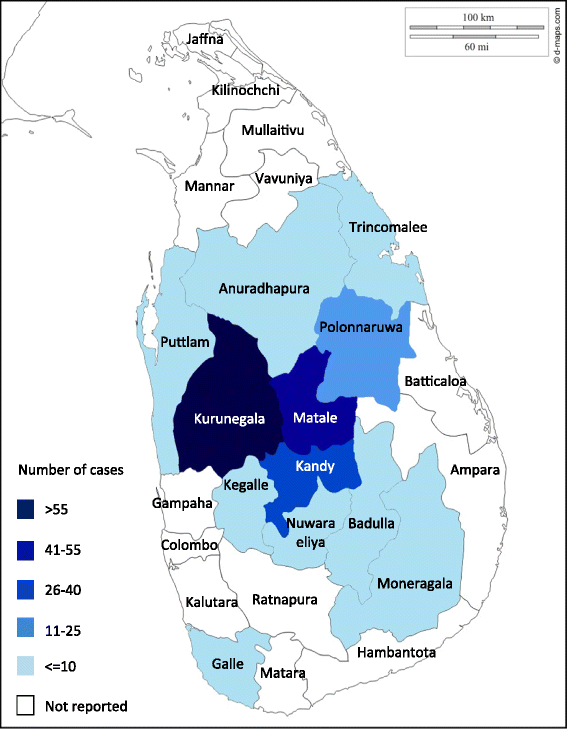Clinical and epidemiological characteristics of cutaneous leishmaniasis in Sri Lanka
- PMID: 29510669
- PMCID: PMC5838877
- DOI: 10.1186/s12879-018-2999-7
Clinical and epidemiological characteristics of cutaneous leishmaniasis in Sri Lanka
Abstract
Background: Leishmaniasis, a vector borne tropical/subtropical disease caused by the protozoan Leishmania is transmitted to humans by sandfly vectors Phlebotomus and Lutzomyia. The principal form found in Sri Lanka is cutaneous leishmaniasis (CL) and is caused by Leishmania donovani. A rising trend in disease prevalence has been observed recently in Sri Lanka and the island is in fact the newest endemic focus in South Asia. Determining the prevalence of smear positivity among clinically suspected CL patients, identifying risk factors and specific clinical presentations of CL in order to implement preventive and early treatment strategies were the objectives of this study.
Methods: A sample of 509 clinically suspected cases of CL referred to the Department of Parasitology from all across Sri Lanka between 2005 and 2015 was selected consecutively. Diagnosis was confirmed by microscopic visualization of the Leishmania amastigote from the slit skin smear. A structured questionnaire was used to identify exposure related risk factors and a clinical examination was performed to identify lesion characteristics.
Results: Out of 509 clinical cases, 41.5% (n = 211) were smear positive. The study population ranged from ages 1 to 80 years (mean age = 34.76) and the most affected age group was 40-49. Of the smear positives, 58.85% were males. Majority (47.86%) were from the North Western region (Kurunegala) of the country and were exposed to scrub jungles. Sand fly exposure (p = 0.04) and positive contact history (p = 0.005) were significant risk factors for smear positivity. Erythema (p = 0.02), lack of pruritus (p = 0.02) and scaly appearance (p = 0.003) were significant lesion characteristics in smear positivity. Lesions were commonly found in the exposed areas and the commonest morphological type was papulo-nodular.
Conclusions: An increasing trend in the spread of cutaneous leishmaniasis from endemic to non-endemic areas has become evident. Positive contact history and sandfly exposure were significant risk factors for smear positivity which may indicate the possibility of human reservoir hosts in infection transmission. Lack of pruritus, scaly appearance and erythema were highly significant lesion characteristics associated with Leishmania positive smears which can be used for the clinical diagnosis of CL.
Keywords: Cutaneous Leishmaniasis; Leishmania donovani; Sri Lanka.
Conflict of interest statement
Ethics approval and consent to participate
The ethical clearance was approved by the Ethics Review Committee, Faculty of Medicine, University of Peradeniya, Sri Lanka. All participants were informed that their participation was voluntary and the procedure used did not pose any potential risk and their identities will be kept strictly confidential. Informed written consent forms were obtained from all the participants who volunteered to participate in the study and parental consent was obtained for all participants under the age of 18. All information was kept in confidence.
Consent for publication
Not applicable.
Competing interests
The authors declare that they have no competing interests.
Publisher’s Note
Springer Nature remains neutral with regard to jurisdictional claims in published maps and institutional affiliations.
Figures
References
-
- Kumar R, Bumb RA, Salotra P. Evaluation of localized and systemic immune responses in cutaneous leishmaniasis caused by Leishmania tropica: interleukin-8, monocyte chemotactic protein-1 and nitric oxide are major regulatory factors. Immunology. 2010;130(2):193–201. doi: 10.1111/j.1365-2567.2009.03223.x. - DOI - PMC - PubMed
MeSH terms
LinkOut - more resources
Full Text Sources
Other Literature Sources




